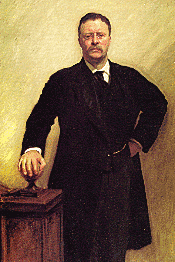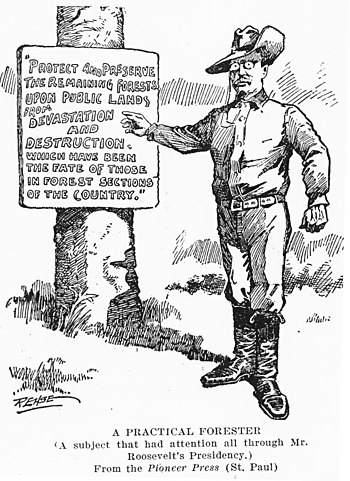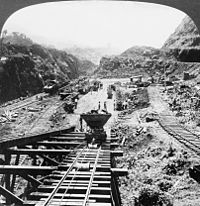Presidency of Theodore Roosevelt: Difference between revisions
cartoon |
|||
| Line 19: | Line 19: | ||
===Coal Strike of 1902=== |
===Coal Strike of 1902=== |
||
[[Image:Coal.JPG|thumb|350px|left|TR teaches the childish coal barons a lesson; 1902 editorial cartoon]] |
[[Image:Coal.JPG|thumb|350px|left|TR teaches the childish coal barons a lesson; 1902 editorial cartoon]] |
||
===Anthracite Coal Strike of 1902=== |
|||
A national emergency was averted in 1902 when Roosevelt found a compromise to the Anthracite coal strike that threatened the heating supplies of most homes. See [[Coal Strike of 1902]] |
|||
===Trust Busting=== |
===Trust Busting=== |
||
Revision as of 04:57, 31 March 2006
Theodore Roosevelt, was the 26th (1901–1909) President of the United States. He had been the 28th Vice President before becoming President upon the assassination of President William McKinley. Due to his unique personality and reformist policies, called the "Square Deal" Roosevelt is considered one of the ablest presidents
Overview
McKinley was shot by an anarchist on September 6, 1901, and died September 14, putting Roosevelt into the presidency. He continued McKinley's cabinet and pledged himself to carry out McKinley's programs. One of his first notable acts as President was to deliver a 20,000-word address to the House of Representatives on December 3, 1901 [1], asking Congress to curb the power of large corporations (called trusts) "within reasonable limits." For this and subsequent actions, he has been called a "trust-buster."
Roosevelt relished the Presidency and seemed to be everywhere at once. He took Cabinet members and friends on long, fast-paced hikes, boxed in the state rooms of the White House, romped with his children, and read voraciously. He was permanently blinded in one eye during one of his boxing bouts.
In 1904, Roosevelt ran for President in his own right and won in a landslide victory.
Building on McKinley's effective use of the press, Roosevelt made the White House the center of news every day, providing interviews and photo opportunities.
Domestic Policy
Progressivism
Determined to create what he called a "Square Deal" between business and labor, Roosevelt pushed several pieces of progressive legislation through Congress.

Progressivism in the United States was the most powerful political force of the day, and in the first dozen years of the century Roosevelt was its most articulate spokesman. Progressivism meant expertise, and the use of science, engineering, technology and the new social sciences to identify the nation's problems, and identify ways to eliminate waste and inefficiency and to promote modernization. Roosevelt, trained as a biologist, identified himself and his programs with the mystique of science. The other side of Progressivism was a burning hatred of corruption and a fear of powerful and dangerous forces, such as political machines, labor unions and especially the new large corporations — called "trusts" — which seemed to have emerged overnight. Roosevelt, the former deputy sheriff on the Dakota frontier, and police commissioner of New York City, knew evil when he saw it and was dedicated to destroying it. Roosevelt's moralistic determination set the tone of national politics.
Coal Strike of 1902
Anthracite Coal Strike of 1902
A national emergency was averted in 1902 when Roosevelt found a compromise to the Anthracite coal strike that threatened the heating supplies of most homes. See Coal Strike of 1902
Trust Busting
Trusts were increasingly the central issue in politics, with public opinion fearing that large corporations could impose monopolistic prices to cheat the consumer and squash small independent companies. By 1904, 318 trusts controlled about two-fifths of the nation's manufacturing output, not to mention powerful trusts in non-manufacturing sectors such as railroads, local transit, and banking. Roosevelt decided to do something about it. A few historians credit McKinley with starting the trust-busting era, but most credit Roosevelt, the "Trust Buster." Once President, Roosevelt worked to increase the regulatory power of the federal government. Regulation of railroads was strengthened by the Elkins Act (1903) and especially the Hepburn Act of 1906, which had the effect of favoring merchants over the railroads. Under his leadership, the Attorney General brought forty-four suits against businesses that were claimed to be monopolies, most notably J.P. Morgan's Northern Securities Company, a huge railroad combination, and J. D. Rockefeller's Standard Oil Company. Both were successful, with Standard Oil broken into over 30 smaller companies that eventually competed with one another. To raise the visibility of labor and management issues, he established a new federal Department of Labor and Commerce.
Pure Food and Drugs
In response to public clamor, Roosevelt pushed Congress to pass the Pure Food and Drug Act of 1906, as well as the Meat Inspection Act of 1906.
Conservation
Roosevelt was a prominent conservationist, putting the issue high on the national agenda. He worked with all the major figures of the movement, especially his chief advisor on the matter, Gifford Pinchot. Roosevelt was deeply committed to conserving natural resources, and is considered to be the nation's first conservation President. He encouraged the Newlands Reclamation Act of 1902 to promote federal construction of dams to irrigate small farms and placed 230 million acres (360,000 mi² or 930,000 km²) under federal protection. Roosevelt set aside more Federal land for national parks and nature preserves than all of his predecessors combined.

Roosevelt established the United States Forest Service, signed into law the creation of five National Parks, and signed the 1906 Antiquities Act, under which he proclaimed 18 new U.S. National Monuments. He also established the first 51 Bird Reserves, four Game Preserves, and 150 National Forests, including Shoshone National Forest, the nation's first. The area of the United States that he placed under public protection totals approximately 230,000,000 acres.
Gifford Pinchot had been appointed by McKinley as chief of Division of Forestry in the Department of Agriculture. In 1905, his department gained control of the national forest reserves. Pinchot promoted private use (for a fee) under federal supervision. In 1907, Roosevelt designated 16 million acres (65,000 km²) of new national forests just minutes before a deadline.
In May 1908, Roosevelt sponsored the Conference of Governors held in the White House, with a focus on natural resources and their most efficient use. Roosevelt delivered the opening address: "Conservation as a National Duty."
In 1903 Roosevelt toured the Yosemite Valley with John Muir, who had a very different view of conservation, and tried to minimize commercial use of water resources and forests. Working through the Sierra Club he founded, Muir succeeded in 1905 in having Congress transfer the Mariposa Grove and Yosemite Valley to the National Park Service. While Muir wanted nature preserved for the sake of pure beauty, Roosevelt subscribed to Pinchot's formulation, "to make the forest produce the largest amount of whatever crop or service will be most useful, and keep on producing it for generation after generation of men and trees." [1]
Race
Although Roosevelt did some work improving race relations, he, like most leaders of the Progressive Era, lacked initiative on most racial issues. Booker T. Washington, the most important black leader of the day, was the first African American to be invited to dinner, on October 16, 1901, at the White House, where he discussed politics and racism with Roosevelt. News of the dinner reached the press two days later. The white public outcry following the dinner was so strong, especially from the Southern states, that Roosevelt never repeated the experiment.
Publicly, Roosevelt spoke out against racism and discrimination, and appointed many blacks to lower-level Federal offices, and wrote fondly of the "Buffalo Soldiers," led by "Black Jack" Pershing, who had fought beside his Rough Riders at the Battle of San Juan Hill in Cuba in July 1898. Roosevelt opposed school segregation, having ended the practice as Governor of New York. T.R. also did not subscribe to anti-Semitism—he was the first to appoint a Jew, Oscar S. Straus, to the Presidential Cabinet.
Like most intellectuals of the era, Roosevelt believed in evolution. He saw the different races as having reached different levels of civilization (with whites at the top and blacks at the bottom). Every race, and every individual, was capable of unlimited improvement, Roosevelt felt. Furthermore, a new "race" (in the cultural sense, not biological) had emerged on the American frontier, the "American race," and it was quite distinct from other ethnic groups, such as the Anglo-Saxons. Roosevelt thought himself as Dutch, not Anglo-Saxon. After criticism of Washington's invitation to the White House, Roosevelt seemed to wilt publicly on the cause of racial equality. In 1906, he approved the dishonorable discharges of three companies of black soldiers who refused his order to testify regarding a riot in Brownsville, Texas, known as the Brownsville Raid.
Radical shift, 1907-1908
By 1907-08, his last two years in office, Roosevelt was increasingly distrustful of big business, despite its close ties to the Republican party in every large state. Abandoning his earlier caution and conservatism, Roosevelt freely lambasted his conservative critics and called on Congress to enact a series of radical new laws — the Square Deal — that would regulate the economy. He wanted a national incorporation law (all corporations had state charters, which varied greatly state by state), a federal income tax and inheritance tax (both targeted on the rich), limits on the use of court injunctions against labor unions during strikes (injunctions were a powerful weapon that mostly helped business), an employee liability law for industrial injuries (pre-empting state laws), an eight-hour law for federal employees, a postal savings system (to provide competition for local banks), and, finally, campaign reform laws.

None of his agenda was enacted, and Roosevelt carried over the ideas into the 1912 campaign. Roosevelt's increasingly radical stance proved popular in the Midwest and Pacific Coast, and among farmers, teachers, clergymen, clerical workers and some proprietors, but appeared as divisive and unnecessary to eastern Republicans, corporate executives, lawyers, party workers, and Congressmen.
Foreign policy

Roosevelt urged the United States to build a strong navy. He believed in an imperial mission for the United States, and that the U.S. could eventually be pulled into war in the Pacific Ocean with the Japanese people. Roosevelt ordered what came to be called the Great White Fleet (due to its gleaming white paint) on an around-the-world cruise, including a prominent stop in Japan. Roosevelt hoped to ease Japanese-American tensions and to show the Japanese leadership, as well as the rest of the world, the global reach of the United States' military might. The Great White Fleet returned to the U.S. in 1909, and Roosevelt had the pleasure of reviewing the Fleet just before leaving office. As a tribute to him, several Navy warships have been named after Roosevelt over the years, including a Nimitz class supercarrier. Roosevelt helped to expand the Navy greatly. By 1904, the United States had the fifth largest Navy in the world; by 1907, it had the third largest.
Roosevelt Corollary
Roosevelt also added a corollary to the Monroe Doctrine. His Roosevelt Corollary stated that the United States had a right to intervene in Latin American affairs when necessary, especially to guarantee debt payment and to promote peace. However, his corollary extended the Monroe Doctrine by still stating that European nations should not interfere in Western Hemisphere matters.
Panama Canal

In 1903, Roosevelt encouraged the local political class in Panama to form a nation independent from Colombia, after that nation refused the American terms for the building of a canal across the isthmus. Roosevelt dispatched navy vessels to the area to apply political pressure on the Colombian government, allowing the Panamanian rebels to secede without much opposition. The new nation of Panama sold a canal zone to the United States for 10 million U.S. dollars and a steadily increasing yearly sum. Roosevelt felt that a passage through the Isthmus of Panama was vital to protect American interests and to create a strong and cohesive United States Navy. The resulting Panama Canal was completed in 1914 and revolutionized world travel and commerce.
Russo-Japanese War
In 1905, Roosevelt became the first president to negotiate peace in a major foreign war between Japan and Russia. Roosevelt won a Nobel Peace Prize in 1906 for his work to hasten the end of the Russo-Japanese War.
Administration and Cabinet
Supreme Court appointments
Roosevelt appointed three Justices to the Supreme Court of the United States:
- Oliver Wendell Holmes, Jr. - 1902
- William Rufus Day - 1903
- William Henry Moody - 1906
Lodge, who served as a member of the United States Senate for the state of Massachusetts, convinced Roosevelt that Holmes would be a "safe" appointment and would not oppose Roosevelt's policies. In August 1902 Roosevelt appointed Holmes to the Supreme Court. However, Lodge's assurance that Holmes would be "safe" turned out to be mistaken, and Roosevelt later regretted appointing Holmes to the Supreme Court for the latter's striking down of several reforms Roosevelt supported.
William Rufus Day, former Secretary of State for McKinley, had been appointed by the latter to the U.S. Circuit Court of Appeals for four years after leaving his post in the cabinet. Roosevelt appointed him to the Supreme Court in January 1903. Day would later oppose the President's position on a number of issues, such as the regulation of hours and wages of labor.
Moody, Roosevelt's Secretary of the Navy and Attorney General, was appointed to the Court in December 1906, but he only stayed on the court for less than four years.
States admitted to the union
One state, Oklahoma, was admitted to the Union.
Other references
Primary sources
- Brands, H.W. ed. The Selected Letters of Theodore Roosevelt. (2001)
- Harbaugh, William ed. The Writings Of Theodore Roosevelt (1967). A one-volume selection of Roosevelt's speeches and essays.
- Hart, Albert Bushnell and Herbert Ronald Ferleger, eds. Theodore Roosevelt Cyclopedia (1941), Roosevelt's opinions on many issues.
- Morison, Elting E., John Morton Blum, and Alfred D. Chandler, Jr., eds., The Letters of Theodore Roosevelt, 8 vols. (1951-1954). Very large, annotated edition of letters from TR.
- Roosevelt, Theodore (1999). Theodore Roosevelt: An Autobiography. online at Bartleby.com.
- Roosevelt, Theodore. The Works of Theodore Roosevelt (National edition, 20 vol. 1926); 18,000 pages containing most of TR's speeches, books and essays, but not his letters; a CD-ROM edition is available; some of TR's books are available online through Project Bartleby
Secondary Sources
- Beale Howard K. Theodore Roosevelt and the Rise of America to World Power. (1956).
- Blum, John Morton The Republican Roosevelt. (1954). Series of essays that examine how TR did politics
- Brands, H.W. Theodore Roosevelt (2001)
- Cooper, John Milton The Warrior and the Priest: Woodrow Wilson and Theodore Roosevelt. (1983) a dual biography
- Gould, Lewis L. The Presidency of Theodore Roosevelt. (1991)
- Harbaugh, William Henry. The Life and Times of Theodore Roosevelt. (1963)
- Keller, Morton, ed., Theodore Roosevelt: A Profile (1967) excerpts from TR and from historians.
- Morris, Edmund Theodore Rex. (2001)
- Mowry, George. The Era of Theodore Roosevelt and the Birth of Modern America, 1900-1912. (1954)
- Pringle, Henry F. Theodore Roosevelt (1932; 2nd ed. 1956)
- Rhodes, James Ford Rhodes. The McKinley and Roosevelt Administrations, 1897-1909 (1922)
- ^ Pinchot, Gifford (1947). Breaking New Ground, p. 32. Island Press. ISBN 1-55963-670-X.
